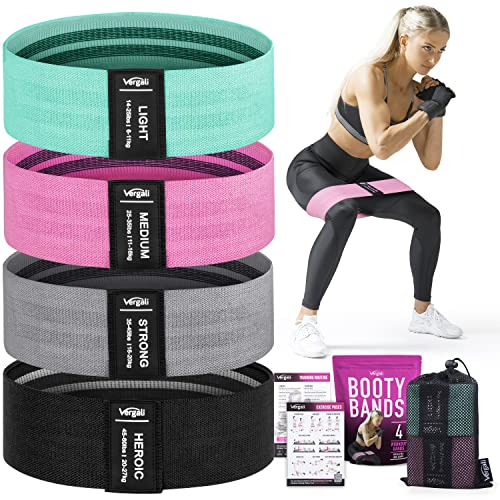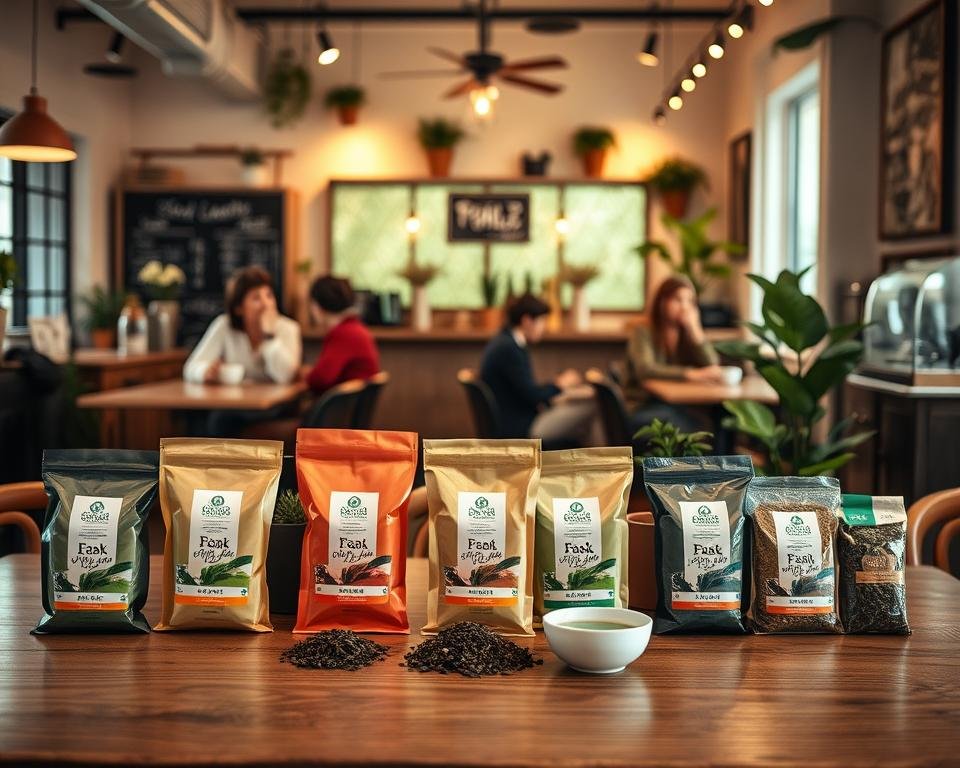What if you had a complete encyclopedia of exercises right at your fingertips—a definitive, A-Z exercise list that could help you build any workout for any goal? The internet is saturated with conflicting fitness advice, flashy trends, and “quick-fix” routines that rarely deliver. It’s time to cut through the noise. This is not another fleeting fitness fad; this is your permanent library for building a stronger, more resilient body.
Our goal here at go4healthnfitness.com is to provide an honest, evidence-based wellness guide. This comprehensive, A-Z guide is the structured solution you’ve been searching for. We will break down the best exercises for arms, abs, legs, and more, providing a foundational resource you can return to again and again. Let’s build your ultimate full-body workout routine, one letter at a time.
- Cast Iron
- HIGH-QUALITY CAST IRON CONSTRUCTION: Built to last of solid cast iron with no welds, weak spots, or seams. Great for tra…
- DURABLE VINYL COATED FINISH: Encased with vinyl to prevent corrosion, increase durability, protect flooring & enhance ap…
- latex
- Imported
- WON’T PINCH BARE LEGS. This at home workout equipment can be used over clothes or on bare skin without that horrible pin…
- MAXIMIZE RECOVERY: Core Power fights post-workout fatigue with high-quality protein to help refuel, rehydrate and rebuil…
- HIGH-QUALITY PROTEIN: Recovery starts with protein. Protein works to repair and rebuild muscle to help you power on to y…
- CONTAINS ALL 9 ESSENTIAL AMINO ACIDS: Made from fairlife ultra-filtered milk, Core Power Elite Vanilla is a delicious wa…
Your Ultimate Workout Cheat Sheet
This article is your go-to reference, but if you only remember a few key things, make them these:
- Form Before Load: The quality of a repetition is always more important than the weight you lift or the number of reps you complete. Master the movement first.
- Variety Is the Engine of Progress: Your body is smart. It adapts. Mixing up exercises from this A-Z list prevents plateaus and ensures balanced muscle development.
- Balance Compound & Isolation: A great full-body workout routine includes compound exercises (like squats) that work multiple muscles at once and isolation exercises (like bicep curls) that target specific ones.
- Consistency Over Intensity: A moderately challenging workout you do three times a week is infinitely better than a grueling, all-out session you only manage once a month.
The A-Z Exercise Library: Your Blueprint for a Full-Body Workout
Here it is: your alphabetical guide to the most effective exercises. For each one, you’ll find what it targets, how to do it correctly, and a pro tip to maximize your results.
A is for Arnold Press 💪

A fantastic compound movement for the shoulders, the Arnold Press hits all three heads of the deltoid, giving you a more complete shoulder workout than a standard dumbbell press.
- Muscle Group(s) Targeted: Shoulders (anterior, lateral, and posterior deltoids), Triceps
- How-To Guide:
- Sit on a bench with back support, holding a dumbbell in each hand at shoulder height, palms facing your body.
- In one fluid motion, begin to press the dumbbells overhead while simultaneously rotating your palms to face forward.
- Continue pressing until your arms are fully extended but not locked. Pause at the top.
- Reverse the motion, rotating your palms back toward your body as you lower the dumbbells to the starting position.
- Pro Tip: Don’t use momentum. The “magic” of this exercise is in the rotation and controlled movement. Using a weight that’s too heavy will force you to swing the dumbbells, reducing the muscular tension.
B is for Burpees 🔥
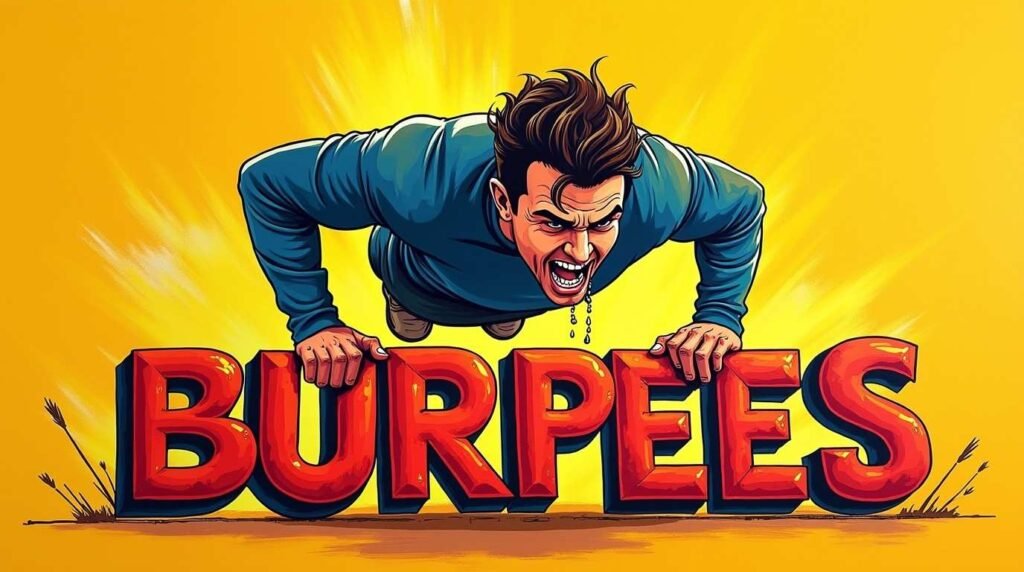
The exercise everyone loves to hate. Why? Because it’s brutally effective. The burpee is a total-body conditioning powerhouse, making it a staple in any at-home or advanced fitness guide.
- Muscle Group(s) Targeted: Full Body (Chest, Shoulders, Legs, Core, Arms)
- How-To Guide:
- Start standing with your feet shoulder-width apart.
- Drop into a squat position and place your hands on the floor in front of you.
- Kick your feet back into a high plank position.
- (Optional) Perform a push-up.
- Jump your feet back toward your hands.
- Explosively jump into the air, reaching your arms overhead. Land softly and immediately begin the next rep.
- Common Mistake: Letting your hips sag during the plank phase. Keep your core tight to protect your lower back.
C is for Chin-Ups

Not to be confused with the pull-up, the chin-up uses an underhand grip (palms facing you), which places more emphasis on the biceps. It’s a premier back and arm builder.
- Muscle Group(s) Targeted: Back (Latissimus Dorsi), Biceps
- How-To Guide:
- Grasp a pull-up bar with an underhand grip, about shoulder-width apart.
- Hang with your arms fully extended. You can bend your knees if your feet touch the ground.
- Pull your body up by driving your elbows down toward the floor.
- Continue until your chin is over the bar.
- Lower yourself back down slowly and with control.
- Pro Tip: Can’t do a full chin-up yet? Start with negative reps. Jump or use a box to get your chin over the bar, then focus on lowering your body as slowly as possible (aim for 3-5 seconds).
D is for Deadlifts 🏋️

If you could only do one exercise for the rest of your life, the deadlift would be a top contender. It is one of the most effective compound exercises, building raw strength from your heels to your neck.
- Muscle Group(s) Targeted: Full Body (focus on Posterior Chain: Hamstrings, Glutes, Lower Back, Traps)
- How-To Guide:
- Stand with your mid-foot under a barbell.
- Hinge at your hips and bend your knees to grip the bar, hands just outside your shins.
- Keep your chest up and your back straight. Your hips should be lower than your shoulders.
- Drive through your heels to lift the weight, keeping the bar close to your body.
- Stand up tall, pulling your shoulders back at the top.
- Reverse the motion by hinging at the hips and maintaining control as you lower the weight to the floor.
- Common Mistake: Rounding the lower back. This is the cardinal sin of deadlifting. Think “proud chest” throughout the entire lift. If you can’t keep your back straight, the weight is too heavy.
E is for Elevated Push-Ups
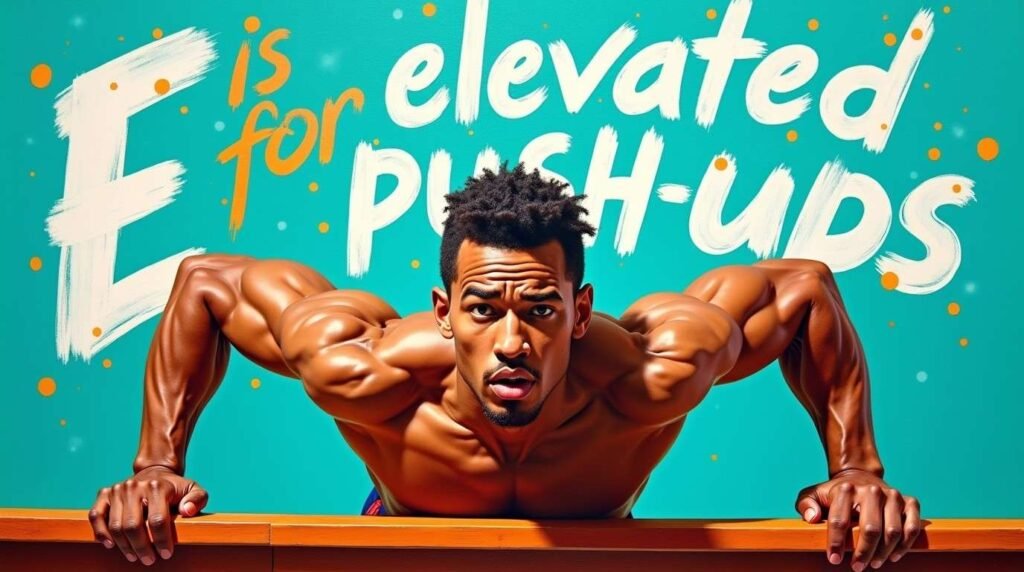
A perfect modification for those still working on their push-up strength. By placing your hands on an elevated surface, you reduce the amount of body weight you have to lift.
- Muscle Group(s) Targeted: Chest (Pectorals), Shoulders, Triceps
- How-To Guide:
- Place your hands slightly wider than shoulder-width on a sturdy bench, box, or step.
- Extend your legs back so your body forms a straight line from head to heels.
- Lower your chest toward the bench, keeping your elbows tucked at about a 45-degree angle.
- Press back up to the starting position.
- Pro Tip: As you get stronger, use a lower surface. This progressively increases the difficulty until you can perform a standard push-up on the floor.
F is for Front Squats
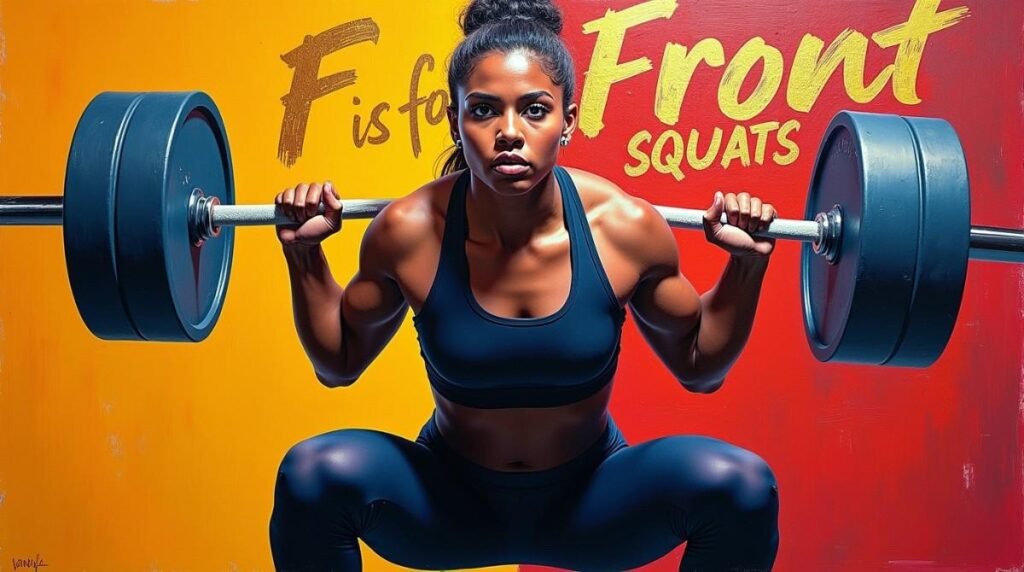
While the back squat is king, the front squat is an incredible alternative that places more emphasis on the quads and challenges your core stability in a unique way.
- Muscle Group(s) Targeted: Legs (Quadriceps, Glutes), Core
- How-To Guide:
- Hold a barbell across the front of your shoulders. You can use a “clean” grip (fingers under the bar) or a “cross-arm” grip.
- Keep your elbows high and your chest up.
- Initiate the squat by sending your hips back and down, as if sitting in a chair.
- Go as deep as you can while maintaining a straight torso.
- Drive through your heels to return to the standing position.
- Quote: “The front squat is a self-correcting exercise,” a strength coach might say. “If your form breaks down—if your back rounds or your elbows drop—you’ll likely drop the bar. It forces you to be honest with your technique.”
G is for Glute Bridges 🍑
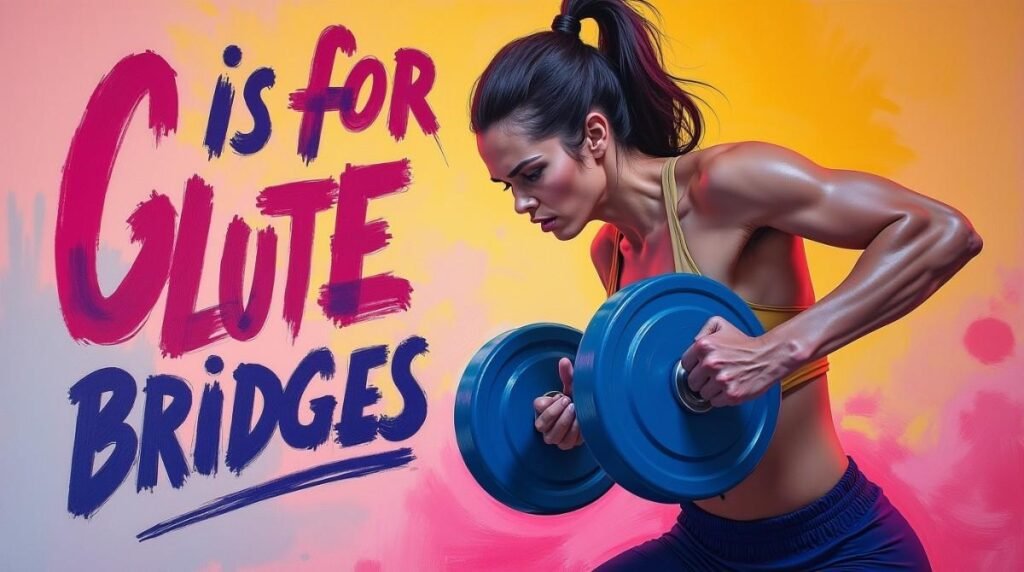
An excellent exercise to “wake up” your glutes before a leg day workout or as a standalone strengthening move. It’s a foundational at-home ab (and glute) workout staple.
- Muscle Group(s) Targeted: Glutes, Hamstrings, Core
- How-To Guide:
- Lie on your back with your knees bent and feet flat on the floor, about hip-width apart.
- Place your arms by your sides with your palms down.
- Drive through your heels and squeeze your glutes to lift your hips off the floor until your body forms a straight line from your shoulders to your knees.
- Pause and squeeze at the top before lowering back down.
- Pro Tip: To increase the difficulty, place a dumbbell or weight plate across your hips.
H is for High Knees
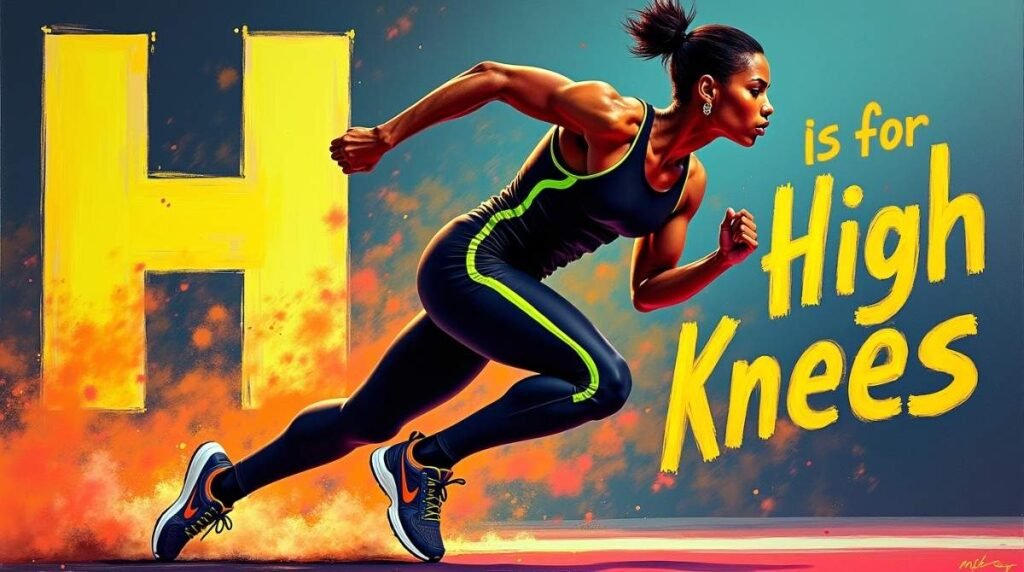
A simple but effective cardiovascular exercise that also improves coordination and power.
- Muscle Group(s) Targeted: Hip Flexors, Core, Calves
- How-To Guide:
- Stand tall with your feet hip-width apart.
- Begin by driving your right knee up toward your chest as high as you can.
- As you lower your right foot, quickly drive your left knee up.
- Continue alternating legs in a running motion. Use your arms to help with momentum and balance.
- Common Mistake: Leaning back. Keep your torso upright and your core engaged.
I is for Inchworm
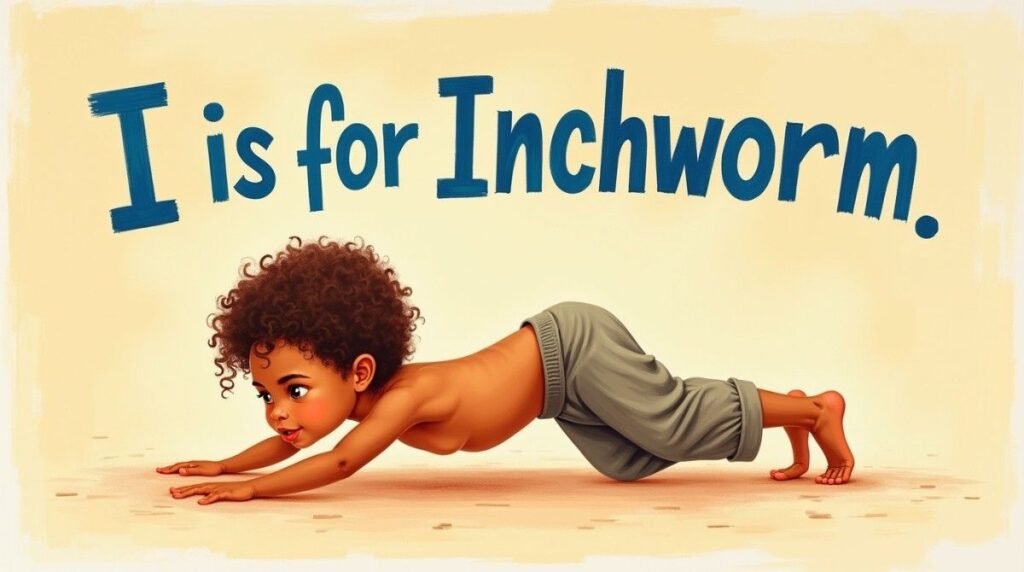
The inchworm is a dynamic stretch and bodyweight exercise that builds shoulder stability and core strength while improving hamstring flexibility.
- Muscle Group(s) Targeted: Shoulders, Core, Hamstrings (stretch)
- How-To Guide:
- From a standing position, hinge at your hips and place your hands on the floor, keeping your legs as straight as possible.
- Walk your hands forward, one at a time, until you are in a high plank position.
- Hold the plank for a second.
- Walk your feet toward your hands in small steps, keeping your legs straight.
- Stand up and repeat.
- Pro Tip: For an extra challenge, add a push-up when you reach the plank position.
J is for Jump Squats
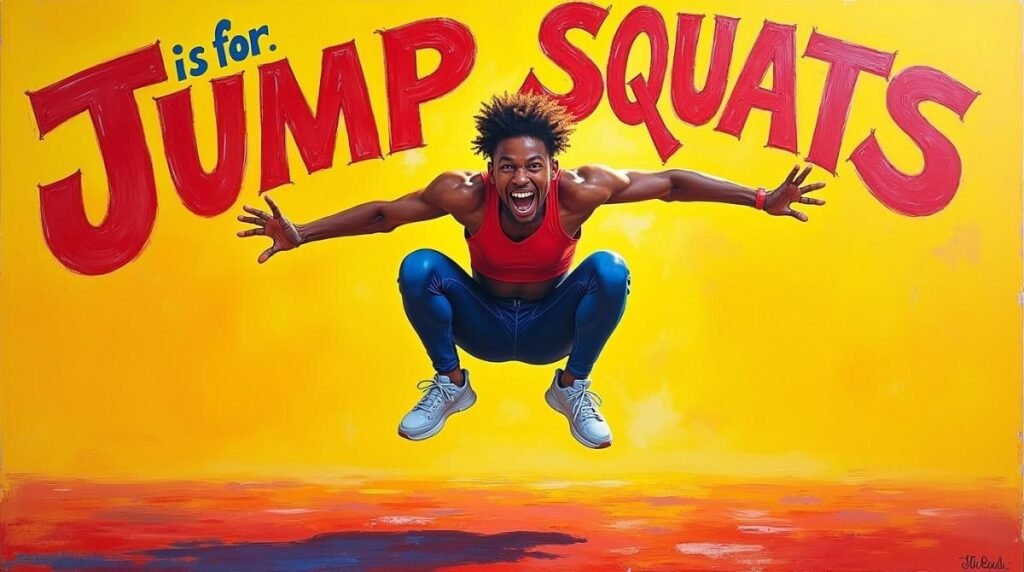
Want to add explosive power to your leg day exercises? The jump squat is your answer. It’s a plyometric move that skyrockets your heart rate and builds athletic power.
- Muscle Group(s) Targeted: Legs (Glutes, Quads, Hamstrings), Calves
- How-To Guide:
- Perform a regular bodyweight squat, lowering until your thighs are at least parallel to the floor.
- From the bottom of the squat, explode upward, jumping as high as you can.
- Land softly on the balls of your feet and immediately lower into the next squat.
- Common Mistake: Landing with stiff knees. Always land softly and absorb the impact by bending your knees and hips.
K is for Kettlebell Swings

A ballistic exercise that builds a powerful posterior chain, increases cardiovascular endurance, and torches calories.
- Muscle Group(s) Targeted: Glutes, Hamstrings, Hips, Core, Back
- How-To Guide:
- Stand with feet slightly wider than shoulder-width, with a kettlebell about a foot in front of you.
- Hinge at your hips to grab the kettlebell with both hands.
- “Hike” the kettlebell back between your legs.
- Forcefully drive your hips forward to propel the kettlebell up to chest height. Your arms are just guiding it; the power comes from your hips.
- Let the kettlebell swing back down between your legs as you hinge at the hips again.
- Pro Tip: The swing is a hinge, not a squat. Your knees should bend only slightly. Think of it as a powerful hip thrust.
L is for Lunges 🦵
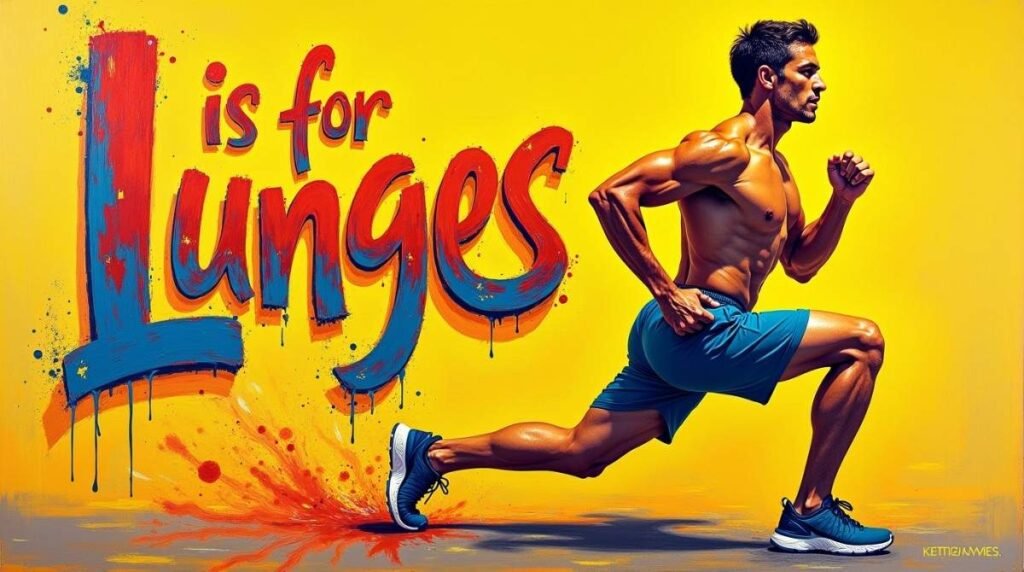
Lunges are a unilateral leg exercise, meaning they work one leg at a time. This is fantastic for identifying and fixing muscle imbalances and improving stability.
- Muscle Group(s) Targeted: Legs (Quads, Glutes, Hamstrings), Core
- How-To Guide:
- Stand tall, then take a large step forward with one leg.
- Lower your hips until both knees are bent at approximately a 90-degree angle. Ensure your front knee is directly above your ankle and your back knee is hovering just off the floor.
- Push off your front foot to return to the starting position.
- Alternate legs or complete all reps on one side before switching.
- Quote: “According to a study in the Journal of Strength and Conditioning Research, focusing on the eccentric (lowering) phase of a lunge can significantly enhance muscle growth and strength.”
M is for Mountain Climbers

A high-intensity core exercise that feels like you’re running in a plank position. It’s excellent for building core endurance and burning calories.
- Muscle Group(s) Targeted: Core, Shoulders, Hip Flexors
- How-To Guide:
- Start in a high plank position, with your hands directly under your shoulders.
- Keeping your core tight, drive your right knee toward your chest.
- Return the right leg to the starting position as you simultaneously drive the left knee toward your chest.
- Continue alternating in a quick, controlled rhythm.
- Common Mistake: Bouncing your hips up and down. Keep your back flat and your hips stable.
N is for Nordic Hamstring Curls
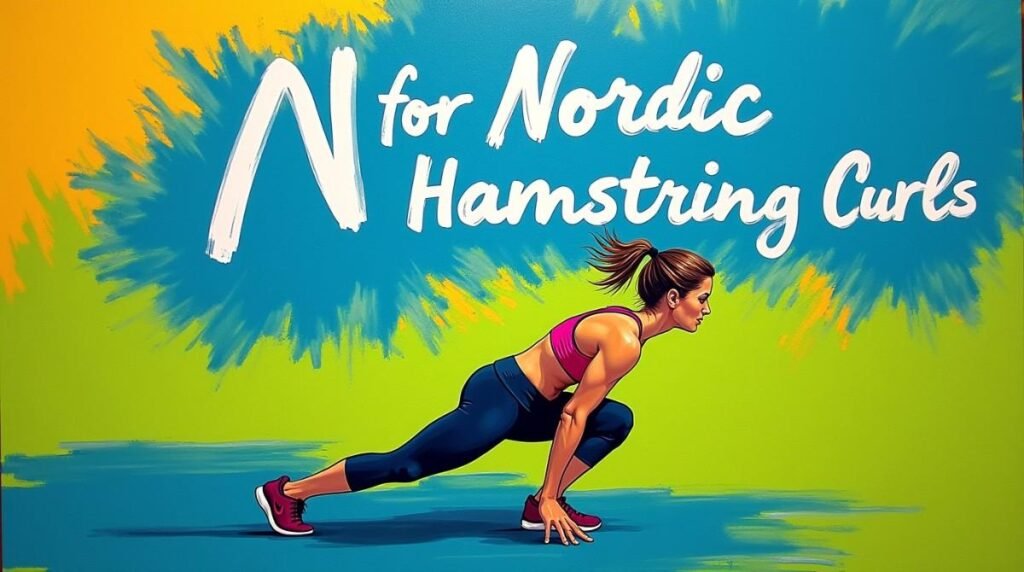
This is one of the most challenging but effective hamstring exercises you can do. It requires a partner or a way to anchor your feet.
- Muscle Group(s) Targeted: Hamstrings, Glutes
- How-To Guide:
- Kneel on a padded surface and have a partner hold your ankles firmly, or anchor them under something sturdy.
- Keeping your body in a straight line from your knees to your head, slowly lower your torso toward the floor.
- Go as far as you can using only your hamstring strength.
- When you can no longer control the descent, catch yourself with your hands.
- Push yourself back up to the starting position.
- Pro Tip: This is an advanced movement. Start with a very small range of motion.
O is for Overhead Press (Military Press)
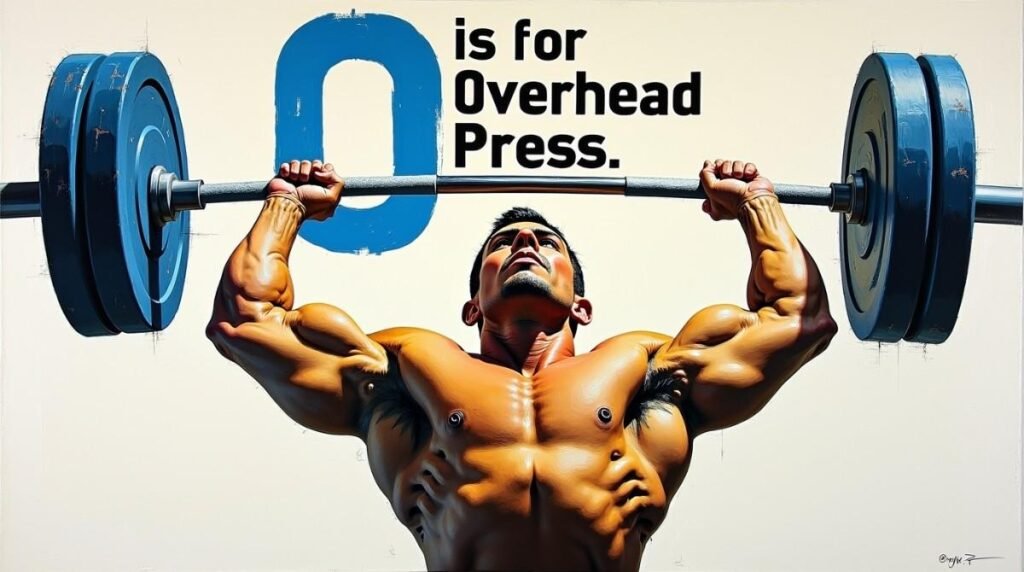
The classic shoulder builder. Performed standing, it’s a true test of total body stability and upper body strength.
- Muscle Group(s) Targeted: Shoulders (Deltoids), Triceps, Upper Chest, Core
- How-To Guide:
- Stand with a barbell resting on your front shoulders, hands slightly wider than shoulder-width.
- Engage your core and glutes to create a stable base.
- Press the bar directly overhead until your arms are fully extended.
- Lower the bar back to your shoulders with control.
- Common Mistake: Arching the lower back excessively. Squeeze your glutes and abs tight to keep your pelvis neutral.
P is for Plank
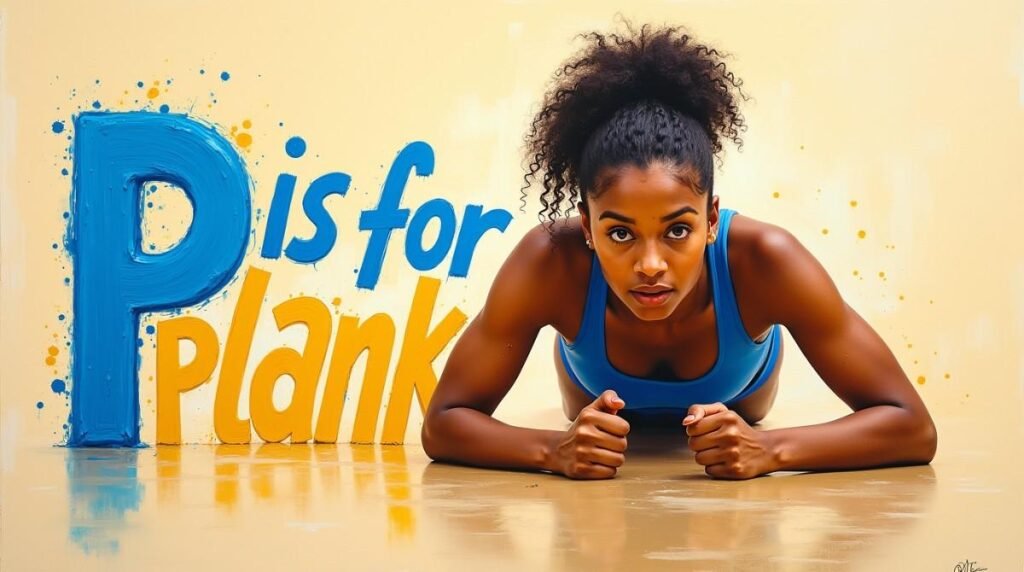
The plank is the quintessential core stability exercise. It teaches you to resist movement through your spine, which is a primary function of your abdominal muscles.
- Muscle Group(s) Targeted: Core (Rectus Abdominis, Transverse Abdominis, Obliques), Shoulders
- How-To Guide:
- Position yourself on your forearms and toes, with your elbows directly under your shoulders.
- Your body should form a straight line from your head to your heels.
- Engage your core and glutes. Don’t let your hips sag or rise too high.
- Hold this position for the desired time.
- Pro Tip: For an even greater core challenge, try a side plank to target your obliques.
Q is for Quadruped Hip Extensions
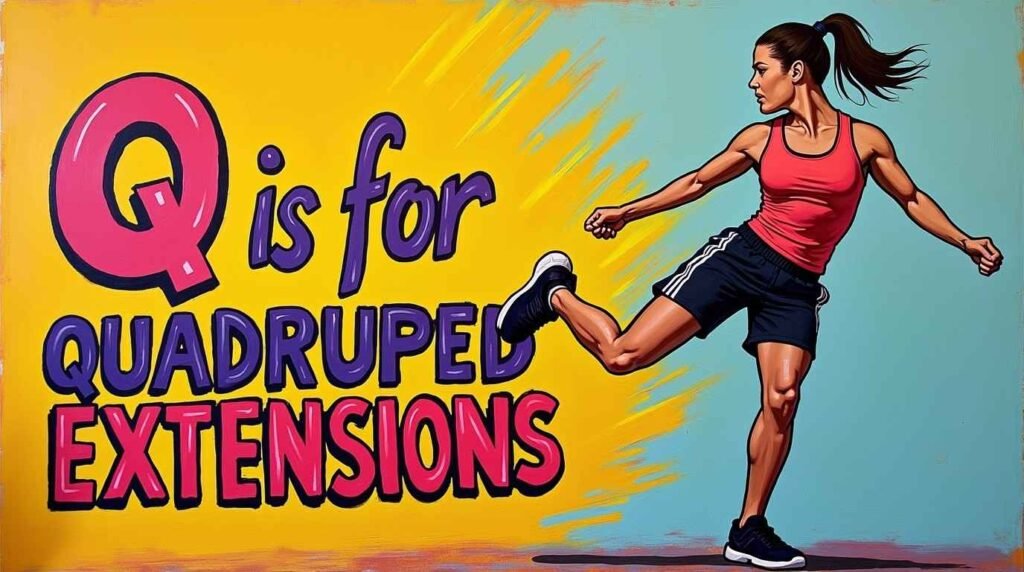
A simple but powerful exercise for targeting the glutes without loading the spine.
- Muscle Group(s) Targeted: Glutes, Hamstrings
- How-To Guide:
- Start on all fours, with your hands under your shoulders and your knees under your hips.
- Keeping your knee bent at 90 degrees, lift one leg up behind you, driving your heel toward the ceiling.
- Squeeze your glute at the top of the movement.
- Lower the leg back to the starting position with control.
- Common Mistake: Arching the back to lift the leg higher. The movement should come from the hip, not the spine.
R is for Rows (Bent-Over)

Rows are to your back what the bench press is to your chest. They are a fundamental movement for building a thick, strong back.
- Muscle Group(s) Targeted: Back (Lats, Rhomboids, Traps), Biceps
- How-To Guide:
- Hold a barbell or dumbbells with an overhand grip.
- Hinge at your hips until your torso is nearly parallel to the floor, maintaining a flat back.
- Pull the weight up toward your lower chest, squeezing your shoulder blades together.
- Lower the weight with control.
- Pro Tip: Think about pulling with your elbows, not your hands. This helps engage the back muscles more effectively.
S is for Squats

The undisputed king of leg day exercises. The squat is a fundamental human movement pattern that builds lower body strength, size, and function like nothing else.
- Muscle Group(s) Targeted: Legs (Quads, Glutes, Hamstrings), Core, Lower Back
- How-To Guide:
- Stand with your feet shoulder-width apart, toes pointing slightly out.
- Keep your chest up and your core braced.
- Initiate the movement by sending your hips back and down.
- Lower until your thighs are parallel to the floor or deeper, if your mobility allows.
- Drive through your heels to return to the starting position.
- Common Mistake: Letting your knees cave inward. Actively push your knees out so they track in line with your feet.
T is for Triceps Dips
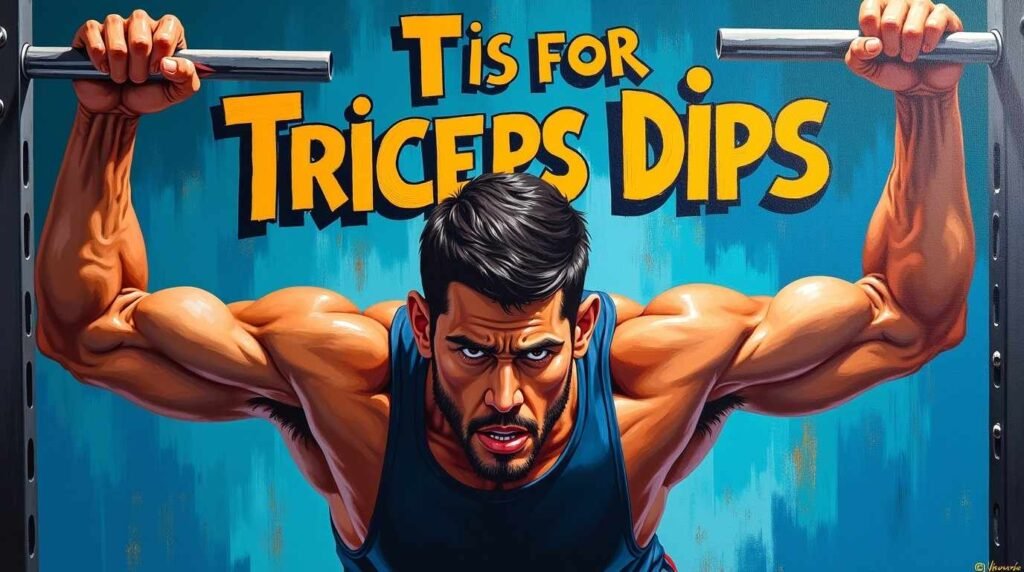
Using just a bench or a chair, dips are one of the best exercises for arms, specifically targeting the triceps.
- Muscle Group(s) Targeted: Triceps, Chest, Shoulders
- How-To Guide:
- Sit on the edge of a bench and place your hands on the edge, just outside your hips.
- Slide your hips forward off the bench, supporting your weight with your arms. Keep your legs straight out in front of you (harder) or bent (easier).
- Lower your body by bending your elbows until they are at about a 90-degree angle.
- Press through your palms to raise your body back to the start.
- Pro Tip: Keep your back close to the bench to put the stress on your triceps, not your shoulder joints.
U is for Upright Rows

This exercise targets the side deltoids and upper traps, helping to build broader-looking shoulders.
- Muscle Group(s) Targeted: Shoulders (Lateral Deltoids), Traps
- How-To Guide:
- Hold a barbell or dumbbells with an overhand grip, hands closer than shoulder-width.
- Pull the weight straight up toward your chin, leading with your elbows.
- Keep the weight close to your body.
- Lower with control.
- Caution: If you have shoulder impingement issues, this exercise may not be for you. A great alternative is the Y-Raise.
V is for V-Ups
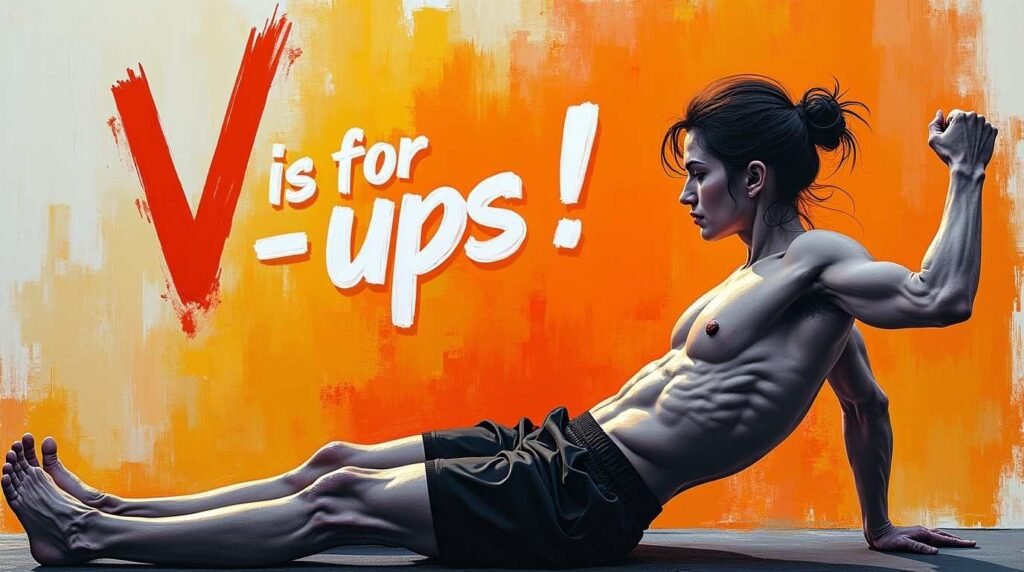
A challenging at-home ab workout that targets the entire rectus abdominis, especially the often-neglected lower portion.
- Muscle Group(s) Targeted: Core (Rectus Abdominis, Obliques), Hip Flexors
- How-To Guide:
- Lie on your back with your legs straight and your arms extended overhead.
- In one explosive movement, simultaneously lift your legs and torso off the floor, reaching your hands toward your feet. Your body should form a “V” shape.
- Lower back down with control.
- Pro Tip: Too hard? Start with tuck crunches, bringing your knees to your chest instead of keeping your legs straight.
W is for Wall Sits

An isometric exercise that builds incredible endurance in your quads and glutes.
- Muscle Group(s) Targeted: Quads, Glutes, Hamstrings
- How-To Guide:
- Stand with your back against a wall.
- Walk your feet out and slide your back down the wall until your knees are at a 90-degree angle and your thighs are parallel to the floor.
- Hold this position.
- Common Mistake: Resting your hands on your thighs. Keep them off your legs to ensure your muscles are doing all the work.
X is for X-Band Walks

A fantastic accessory exercise for hip and glute activation, often used to help with squat and deadlift form.
- Muscle Group(s) Targeted: Hips (Gluteus Medius)
- How-To Guide:
- Place a resistance band around your ankles or just below your knees.
- Stand in an athletic, half-squat position.
- Take a step sideways, leading with one leg, and then bring the other foot in slightly, maintaining tension on the band at all times.
- Take several steps in one direction, then repeat in the other.
- Pro Tip: Stay low and don’t let your feet come all the way together.
Y is for Y-Raises

An excellent move for building strength in the smaller stabilizer muscles of the upper back and shoulders, crucial for posture and shoulder health.
- Muscle Group(s) Targeted: Shoulders (Posterior Deltoids), Back (Lower Traps)
- How-To Guide:
- Lie face down on an incline bench or hinge at the hips with a flat back. Hold a very light dumbbell in each hand.
- With your arms straight and thumbs pointing up, raise your arms up and out so your body forms a “Y” shape.
- Squeeze your shoulder blades at the top.
- Lower with control.
- Pro Tip: Use very light weights. This is a corrective exercise, not a mass-builder.
Z is for Zottman Curls
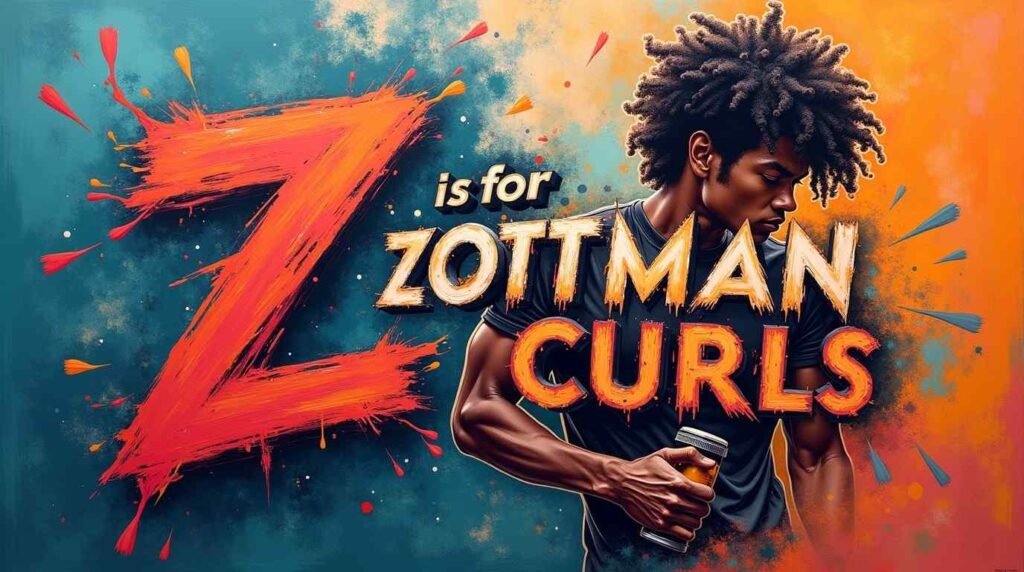
A unique bicep curl variation that also targets the forearms, making it a highly efficient arm-building exercise.
- Muscle Group(s) Targeted: Biceps, Forearms (Brachialis, Brachioradialis)
- How-To Guide:
- Hold a dumbbell in each hand with a standard underhand (supinated) grip.
- Curl the dumbbells up, just like a standard bicep curl.
- At the top of the curl, rotate your wrists so your palms are facing down (pronated grip).
- Lower the dumbbells slowly with this overhand grip.
- At the bottom, rotate your wrists back to the starting underhand grip and repeat.
- Common Mistake: Rushing the negative (lowering) portion. The overhand lowering is key to targeting the forearms.
Sample Full-Body Workout Plan
Here is how you can combine some of these exercises into a structured, 3-day beginner workout plan. Rest 60-90 seconds between sets.
| Day | Focus Area | Exercises (from this guide) | Sets | Reps |
|---|---|---|---|---|
| 1 | Upper Body & Push | Elevated Push-Ups | 3 | As Many As Possible |
| Arnold Press | 3 | 8-12 | ||
| Triceps Dips (on bench) | 3 | 10-15 | ||
| Plank | 3 | 30-60 sec hold | ||
| 2 | Lower Body & Pull | Goblet Squats (using one dumbbell) | 3 | 8-12 |
| Deadlifts (with light weight for form) | 3 | 6-8 | ||
| Lunges | 3 | 10-12 per leg | ||
| Bent-Over Rows (with dumbbells) | 3 | 8-12 | ||
| 3 | Full Body & Core | Burpees | 3 | 8-10 |
| Kettlebell Swings | 3 | 15-20 | ||
| Glute Bridges | 3 | 15-20 | ||
| V-Ups (or Tuck Crunches) | 3 | 10-15 |
Conclusion: Your Fitness Journey from A to Z
You now have a comprehensive, expert-vetted library of exercises. This A-Z exercise list is more than just a collection of movements; it’s a toolkit for building strength, confidence, and a sustainable fitness habit. Remember that the best workout plan is the one you can stick with consistently. Listen to your body, prioritize proper form, and don’t be afraid to challenge yourself.
Your journey doesn’t have to be a massive overhaul overnight. Start small. Pick one exercise from this list that you’ve never tried before and incorporate it into your routine this week. That’s it. That’s how progress begins.
Frequently Asked Fitness Questions ❓
- How do I combine these exercises into a weekly routine? The sample plan above is a great start. A common and effective split is: Day 1: Upper Body, Day 2: Lower Body, Day 3: Full Body, with rest days in between. Or, you can do three full-body workouts per week, choosing 1-2 exercises for each major muscle group (legs, back, chest, shoulders, arms, core) in each session.
- How much rest should I take between sets? For strength and muscle building (hypertrophy), resting 60-90 seconds is a good rule of thumb. For endurance or high-intensity circuits, you might rest for a shorter period, like 30-45 seconds.
- Do I need equipment for all these exercises? No! Many of the most effective exercises are bodyweight-only. Burpees, Squats, Lunges, Push-ups, Planks, Glute Bridges, and Mountain Climbers require zero equipment and can form the core of a powerful at-home workout routine.
- How do I know if I’m using the correct form? This is the most important question. The best way is to film yourself with your phone from the side and compare it to videos of experts performing the movement. Pay close attention to the “Common Mistake” tips in this guide. If something feels painful (not just challenging), stop immediately.
References
- Schoenfeld, B. J., Ogborn, D., & Krieger, J. W. (2017). Dose-response relationship between weekly resistance training volume and increases in muscle mass: A systematic review and meta-analysis. Journal of Sports Sciences, 35(11), 1073–1082. https://pubmed.ncbi.nlm.nih.gov/27433992/
- Coratella, G., Tornatore, G., Caccavale, F., Longo, S., Esposito, F., & Cè, E. (2021). The Dose-Response of Eccentric-Only Training in Skeletal Muscle Adaptation: A Systematic Review and Meta-Analysis of Randomized Controlled Trials. Journal of Functional Morphology and Kinesiology, 6(3), 66. https://www.mdpi.com/2411-5142/6/3/66
- National Institute on Aging. (2021). How Can Strength Training Build Healthier Bodies? https://www.nia.nih.gov/news/how-can-strength-training-build-healthier-bodies
- Cast Iron
- HIGH-QUALITY CAST IRON CONSTRUCTION: Built to last of solid cast iron with no welds, weak spots, or seams. Great for tra…
- DURABLE VINYL COATED FINISH: Encased with vinyl to prevent corrosion, increase durability, protect flooring & enhance ap…
- latex
- Imported
- WON’T PINCH BARE LEGS. This at home workout equipment can be used over clothes or on bare skin without that horrible pin…
- MAXIMIZE RECOVERY: Core Power fights post-workout fatigue with high-quality protein to help refuel, rehydrate and rebuil…
- HIGH-QUALITY PROTEIN: Recovery starts with protein. Protein works to repair and rebuild muscle to help you power on to y…
- CONTAINS ALL 9 ESSENTIAL AMINO ACIDS: Made from fairlife ultra-filtered milk, Core Power Elite Vanilla is a delicious wa…



